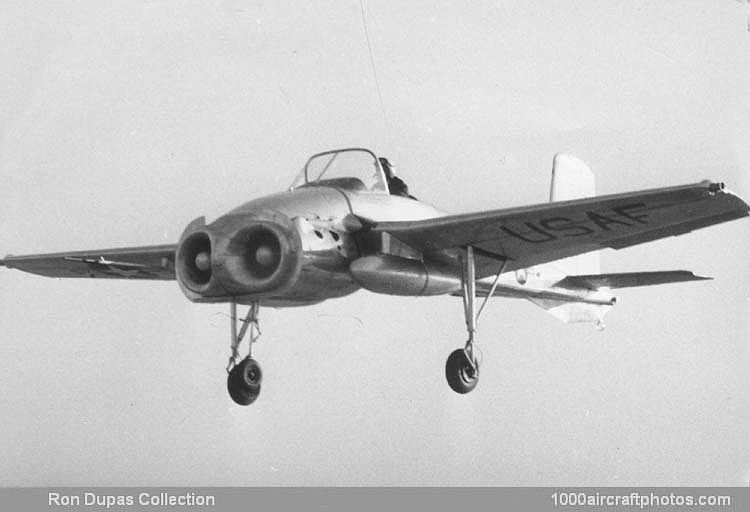04/30/2010. Remarks by Johan Visschedijk: "The X-14 was the first experimental VTOL research aircraft of the jet-deflection type, which was built under USAF contract and serial 56-4022. The single-seat open-cockpit aircraft was of simple design, using Beech 35 Bonanza wings and a Beech T-34 Mentor tail. Two 1,750 lb (794 kg) st Armstrong Siddeley Viper turbojet engines were mounted side-by-side in fuselage nose, exhausting through cascade thrust deflectors. Compressed-air nozzles at wing tips and tail for low-speed or hovering directional and stability control.
During take off and landing, the thrust diverters deflected the jet efflux towards the ground, thus enabling the X-14 to raise itself vertically off the ground by direct jet lift, with its fuselage horizontal. At a safe height, the jet efflux was directed slightly rearward to provide some forward thrust in addition to jet lift. When the forward speed was sufficient for the fixed wings to provide adequate lift, the efflux was redirected towards the rear and the aircraft flew in a conventional manner.
The X-14 made its first hovering flight on February 19, 1957 and first successful transition from hovering to forward flight on May 24, 1958, on both occasions the pilot was David Howe. Registered as N234NA, the aircraft was transferred to the NASA Ames Research Center at Moffett Field, California, on October 2, 1959, becoming the first VTOL aircraft flown there.
To increase thrust margins and stability during hovering the Viper engines were replaced by two 2,680 lb (1,216 kg) st General Electric J85-GE-5 turbojet engines and an analog variable stability system developed by Ames was installed, the aircraft being redesignated X-14A. Conducted by Fred Drinkwater and Ron Gerdes, flight testing of the was resumed in 1960. Extensive flight testing resulted in criteria for longitudinal, lateral, and directional control power, sensitivity and damping.
The X-14A and Ames' new Six-Degree-of-Freedom hover simulator, contributed to the military flying qualities specification and control system development for V/STOL aircraft. The Hawker test pilots, Bill Bedford and Hugh Merewether, flew the X-14A, before they flew the P.1127 (which became the Harrier). To evaluate control characteristics in vertical flight that would be representative of the Apollo lunar lander during final descent to landing on the Moon, the X-14A was also flown by Neil Armstrong in 1965.
In 1971 the aircraft was re-engined with 3,015 lb (1,368 kg) st J85-GE-19 engines, and was fitted with an onboard computer, a digital fly-by-wire control system and a digital variable stability system to enable emulation of landing characteristics of other VTOL aircraft. Redesignated X-14B and reregistered N704NA the aircraft flew for another ten years till it was damaged beyond repair on May 29, 1981, when it made a hard landing as a consequence of a lateral control software design flaw that led to a pilot-induced oscillation.
In 1999 the X-14B was rescued from the scrap yard and is presently in rebuilt state on display at Ropkey Armor Museum in Crawfordsville, Indiana."
